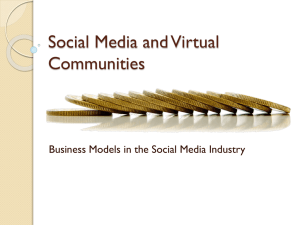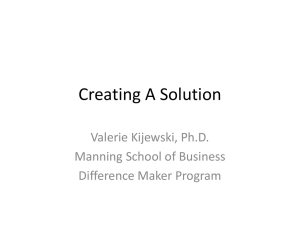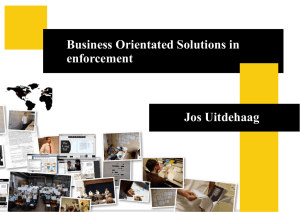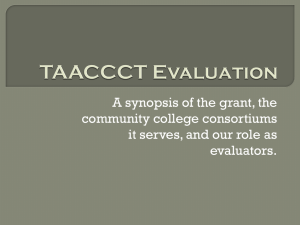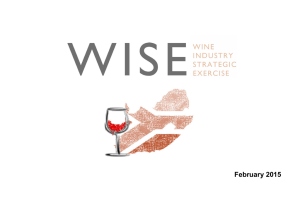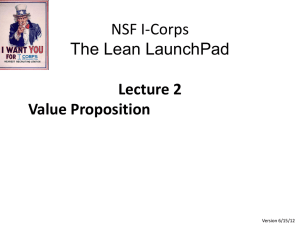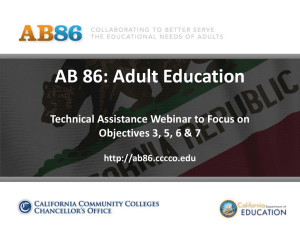Phil DiChiara, Managing Director, The Boston Consortium
advertisement
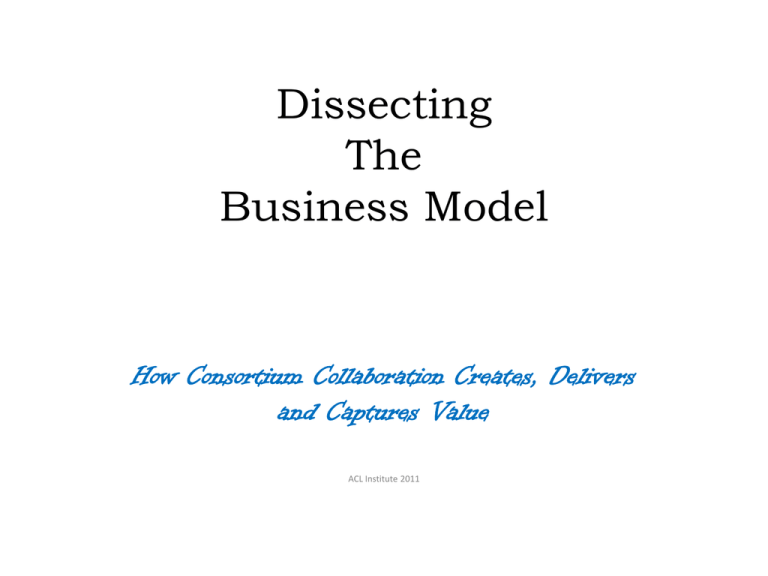
Dissecting The Business Model How Consortium Collaboration Creates, Delivers and Captures Value ACL Institute 2011 The Canvas: Individual Pieces of the Puzzle Key Activities Key Partners Key Resources Cost Structure Relationships Value Proposition Customer Segments Channels Revenue Streams Individual Pieces of the Puzzle Key Activities Key Partners Key Resources Cost Structure -Which Partnership subsets currently drive change most effectively? Relationships Value Proposition Customer Segments Channels Revenue Streams -Which member needs are complementary, and which are competitive? -Where will future externalities change the current canvas? These are the participants within and governance of TBC. They make the business model function by sharing or reducing risk, adding economic scale, bring operational skills to the co-creation table and pulling in middle managers who provide further energy around our mission. Our partnerships include constructing new business units in service to our existing members, acting as a repository of knowledge to facilitate system changes, sharing market information and acting as early warning systems for new regulation or business environment changes, and provision of tools to facilitate affirmative collaboration consistent with our mission and vision. Individual Pieces of the Puzzle Key Activities Key Partners Key Resources Cost Structure Relationships Value Proposition Customer Segments Channels Revenue Streams -Member dues have grown modestly, but are we underresourcing the entity and constraining it’s ability to more rapidly build value for members? -71% of costs are for human resource Creating and delivering value inevitably incurs costs, and are a function of investments in key activities, key resources, project management and implementation. Initially, TBC was cost-driven, where annual fees absorbed all costs, and any grant resource was used to complete delivery of projects of value to a majority of members. In recent years, we have moved to a value-driven model, where pay-to-play has become a major force in implementing large scale, higher value programs that drive a return on investment to participating schools. TBC is a Problem Solving and Networking Platform: -Twenty-three professionally facilitated Communities of Practice provide a forum for best practice exchange, debate on current issues of interest and concern, shared project development, potential new programs and sometimes evolution into business units. -Multi-disciplinary fora to address larger system-thinking issues and opportunities. -Professional Development and Training. -Grant resources often available to lower the barrier to collaboration and reduce the first-dollar risk for project ideas that have merit and quantifiable economic return. -Operation of semi-independent business units to reduce member redundancy, and absent any profit motive. -Knowledge Management and Data Repository so to act as a vehicle for affirmative change. Individual Pieces of the Puzzle -Are their opportunities to grow into areas in which we do not currently have a presence? Such as academic operations like diversity or regional recruitment? Key Activities Key Partners Key Resources Cost Structure Relationships Value Proposition Customer Segments Channels Revenue Streams Individual Pieces of the Puzzle These are the essential ingredients to make the Consortium work: Key Activities Key Partners -LEADERSHIP: Board Commitment and Active Engagement Key Resources Cost Structure Relationships Value Proposition Customer Segments Channels Revenue Streams -HUMAN RESOURCE: Member-school staff awareness and involvement as encourage by the Board. -HUMAN RESOURCE: Trustful Relationships. -FINANCIAL RESOURCE: Adequate dues and grant support, in appropriate balance. -INTELLECTUAL RESOURCE: Our growing base of shared knowledge and shared experience with our own brand of collaboration as experienced over the past fifteen years. -TIME for Reflection and subsequent commitments of energy over time to enact changes that a majority agree upon. -Are we utilizing these resources with maximum effectiveness? - Individual Pieces of the Puzzle Key Activities Key Partners Key Resources Cost Structure Relationships Value Proposition Customer Segments Channels Revenue Streams -Can we expand the value proposition by adding new revenue streams to TBC that will offset cost increases elsewhere? -Will our value proposition be threatened by the changing economic environment within HE? -The value proposition is why members stay active and how they receive benefit from participation in the Consortium and its activities. -Specifically, for the cost of membership, Boston Consortium members receive opportunities to leverage mutual scale, learn from the knowledge and experience of others, co-develop programs of mutual benefit, , customize products and services to the collected needs of our members, and adapt more quickly to changes in the external environment. -The scale of any one of our fifteen members may no longer be adequate to individually solve the problems that are being presented in the marketplace, the regulatory environment or the financial circumstance of the times. -As a safe space for experimentation, the Consortium has the ability to challenge the status quo in a in a manner that minimizes risk and reputation. Relationships are the primary currency of Consortium exchange. -Communities of Practice are the basic building block by which relationships evolve. The ‘safe space’ that is the consortium allows members to engage in candid exchange of problems and ideas, with an eye to viewing the world beyond their own organization’s limitations. Competition for the best idea is often satisfactorily replaced with co-creation of mutually advantageous solutions. Some problems cannot be solved within the confines of a single operational entity…. Individual Pieces of the Puzzle TBC historically attract innovators/ early adopters. Can we do more with majority? Key Activities Key Partners Relationships Value Proposition Customer Segments Key Resources Cost Structure Channels Revenue Streams Are non-member schools a new channel to meet our member needs e.g. Co-HIP? Channels are how we deliver the value proposition: -At the most elemental level, Dialog, debate and deliberation at meetings of the various communities of practice, plus materials documenting activities and intentions comprise an initial channel. -Co-created Projects emerging from these communities, as well as programs, are a second channel. -The highest expressions of value delivery are found in the Major Initiatives and Shared Business Units which culminate with new systems that began as good ideas, and end as practical, operating realities. Relationships are the primary currency of Consortium exchange. -TBC facilitators aid in accelerating discovery of common ground and construction of new problemsolving tools by carefully channeling dialog for optimal productivity, by removing logistical barriers to effective meetings, and offering external resources such as grant support. -Consortium activists are offered a significantly wider view of activities within a given Higher Education domain, so as to compare their processes against other schools with other cultures. Over time, work processes become distinct from cultural artifacts relating to style, internal historical precedent, and even organizational myth-making. -Learning opportunities are created naturally, without artifice, and the lessons are tested and reinforced by intense Group Process. -A generosity of spirit takes hold that enhances both the intellectual exchange and the professional fulfillment related to inclusion in a group of productive and engaged colleague professionals. Individual Pieces of the Puzzle Key Activities Key Partners Key Resources Cost Structure Relationships Value Proposition Customer Segments Channels Revenue Streams Individual Pieces of the Puzzle Is Crossconsortia collaboration the next opportunity? Key Activities Key Partners Relationships Value Proposition Customer Segments Key Resources Cost Structure Channels Revenue Streams Channels are how we deliver the value proposition: -Knowledge transfers from the Communities of Practice back into the member schools. -Actionable initiatives such as Major projects and programs (HMI, Procurement Marketplace, Co-HIP) translate learning and new knowledge into programs, and business units. -Reports, data collections, documents, consultative analysis, external networking and dialog all inform our thinking beyond the walls of an individual institution. -Transfer of funds from grants to form “venture capital for good ideas.” -Leveraging scale from participant schools Consortium Customer Segments are the common needs of a smaller few, and distinguished as a functional subset of the fifteen member whole…. -Not every member has identical needs that support a shared solution, but when four or so do, a core group of schools may form to provide a central or shared solution. Collaboration at TBC is NOT about fifteen schools doing the same thing or in the same way. -Problem identification and common research needs can be scaled and leveraged so that the learning curve is shortened and time-to-solution minimized. -Cost structure vary from school to school, so the attractiveness of a given solution might require significant adaptation within a single school, but leveraging common ground avoids some redundancy while maintaining focus on forward progress as driven by a collaborative social enterprise like TBC. Individual Pieces of the Puzzle Key Activities Key Partners Key Resources Cost Structure Relationships Value Proposition Customer Segments Channels Revenue Streams Should we consider inclusion of NFPs like the Museum of Fine Arts, Kennedy Institute, etc? Individual Pieces of the Puzzle Key Activities Key Partners Key Resources Cost Structure Relationships Value Proposition Customer Segments Channels Revenue Streams For TBC revenue are comprised of dues, grant funds, income from non-member participation and very modest interest income. Dues reflect a debit to the beneficial revenue stream Consortium initiatives must drive to the members. Revenue to TBC minimizes annual dues increases or provides added resource to support new investments in activities that benefit the members. Revenue Streams come to both the Consortium and to the Member Schools Member Schools are provided revenue streams in several different ways: -Cost Avoidance: More efficient systems, eliminations or reductions of redundancy, lower unit costs by aggregated procurement. -Cost Savings by In-sourcing common administrative tasks, where lowered cost and lack of any profit incentive compare favorably to the external market. -Minimization of start-up costs or operating costs for shared programs. -Risk Reduction by spreading/sharing the risk of innovation, and lessening the first dollar cost of risk by careful use of grant funds. -First-mover or empirical learning risk reduction suggests that we need to avoid the mistakes of others. TBC acts as an early-warning system for regulatory and other external dynamics. Operational Cost Reduction Initiatives by Category $ Potential Learning Requirements High Industry Comparable Action Innovation of New Systems •Limited innovation, but optimal capture of current best practice •Example: Active Communities of Practice comparing notes routinely •Key Driver –Consortium Staff Resources •Missing Element: Adequate encouragement by governance •The core of most Consortium activity. •New paradigm, maximum scale •Potentially transformational Key Driver – External Forces and Board Willingness •Missing Element – Courage or crisis •This is the holy grail of consortial accomplishments (2) (4) Individual School Unilateral Action Cross-Institutional Search for Complementary System Adaptations •Economic Scale limited to intraorganizational size. •Usually transactional •Tendency to favor temporary reduction Maximize scale of existing paradigm Example: Co-sourcing otherwise redundant operations •Key Driver – Division VP support •Missing Element – Participant Dedication, time. Low (1) Low (3) Innovation Inter-organization leverage High
